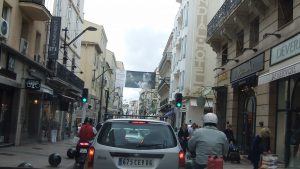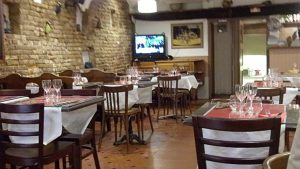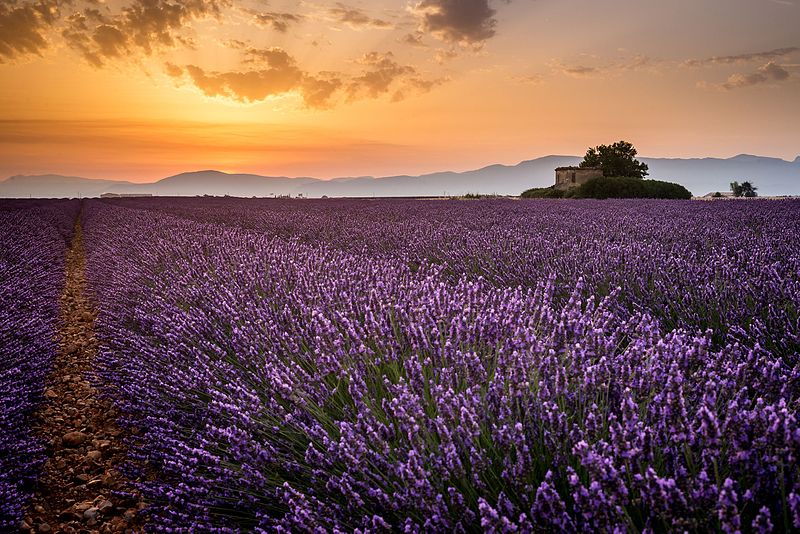By Antonia Lewandowski
The day after France’s nervously awaited national election, I flew into the Côte D’Azur International Airport. Exiting the terminal, I glanced down in the sunlight, astonished at the fresh colors of my travel clothes. The blue, green, and gray stripes of my scarf brightened over a crumpled field jacket. My roller suitcase, battered and scratched, glinted. The concrete pedestrian walkway sparkled under my feet. Instantly, I understood why painters, Picasso in Vallois, Cezanne in Aix-en-Provence, Renoir in Cagnes-sur-Mer, Van Gogh in Nimes, and Matisse in Nice, migrated to the light of the Cote D’Azur, truthfully painting skies blue as the deep end of a swimming pool.
I came for a family celebration. Over the sound of outgoing aircraft, the rumble of baggage, I followed my cousin Jean-Charles to his parked Voyager. Once out of the airport, I turned to look for the Mediterranean Sea, then, traced the low curves of mountains rising toward the Alps. We drove toward Mandelieu, a town in the vicinity of Cannes, the home of my hosts. Once we arrived at the second floor apartment of a condo complex surrounded by landscaped gardens, I left my bags at the door, stretched and walked to the wraparound terrace. The countryside stretched before me, hills in a rolling line.
By the time I stepped off the plane, the election had been decided. Emmanuel Macron, who won by a decisive margin, ended our previous conversations by phone. Now my hosts could plan a leisurely visit, interspersed with museum trips and walks through Cannes and Nice.
But first, we needed groceries. What would I like to eat? With the radio tuned to American music on Radio Rivera 105.6, we drove to the local Casino supermarket in a busy shopping plaza. Inside the store, tile floors and fluorescent lights glared, products stacked on high shelves offered dizzying choices, but the aisles devoted to pastries and cheese, suggested a hint of what I’d expected as traditional, small market ambience.
From abundant displays of produce, we chose heirloom tomatoes and for salad, Rocket, a tender green leaf herb, cousin to the cabbage family. At the register, counter, seated cashiers totaled our purchases at registers that looked like office desks. In a final glance at the aisles, I noticed a display of truffle oil, packaged in ordinary supermarket bottles. Indeed, this was culinary France.
For me jet lag never set in, so the next day we planned a visit to the Matisse Museum in the neighborhood of Cimiez, a short hilly drive. Oleanders, the iconic poplar trees clipped to precision, and old-fashioned roses climbing over the stone and slate walls lined the road. The museum, a 17th Century red and ochre villa on the rue de Matisse, and classified as a landmark, sits adjacent to Roman ruins of Cemenelum and an archeological museum.
At a side entrance, two unsmiling women with purple lipstick and dark eyebrows, fashionably dressed in black, collected the ten Euro entrance fee and briskly handed out brochures. We entered through a nondescript side hallway that led into the reception hall, where afternoon light from the large windows and a curved staircase created the impression of ample space interrupted by a bench positioned to allow the viewing of two “Back” sculptures, two of four of Matisse’s eight-foot bas relief figures. On the bench two young tourists with backpacks and striped socks leaned against each other, sleeping.
Each bronze, “Dos II” (1913) and “Dos III” (1916-7), commanded attention mounted in the stark, white wall. These powerful sculptures contrasted with Doric columns and a Kuros near the elevator. On the second floor, windows with plantation shutters screened the afternoon sun. Small bronze sculptures in yoga poses gleamed on pedestals. Other rooms displayed more figures, a mix of paintings, drawings, prints and personal artifacts.
Finally, we lingered at a room containing preliminary work and models of Matisse’s designs for the famed Rosary Chapel in Vence. One pane of the brilliant blue and yellow stained glass flower design for the chapel stood on a tall mount. Along the walls, black outline drawings and framed sketches of St. Dominic, studies for the final version of murals gave us. In one corner we bent over an architectural model of the chapel. After the museum, we walked to the nearby Roman ruins of Cemenelum, amphitheater, arena and baths, a relic of the city’s ancient past, now adjacent to private homes.
Another day we set out for Cannes, whose holiday reputation dates back to Lord Brougham who came to Cannes in 1834, soon followed by English aristocracy and later, Russian nobles and royalty. They constructed villas and Belle Époque hotels like the Carlton to provide a resort atmosphere for the wealthy from all continents. We imagined James Bond strolling momentarily out of the hotel’s decorative lobby.
On the Promenade de la Croissette, we cruised slowly, as traffic and our tourist intentions allowed a clear view of preparations for the 70th Anniversary of the Cannes Film Festival, one week away.

Image by Professor Antonia Lewandowski
On this waterfront avenue, lined with palm trees, scores of workers were building the red carpet area near the Palais des Festivals, epicenter of the festival’s coming activities. To our left, a string of luxury hotels and designer shops stretched down the boulevard. On the right lay sandy beaches. In the harbor, a yacht nearly as large as a container ship lay at anchor.
Further into the city, we passed under banners strung above the city’s narrow streets. These featured close ups and stills from famous movies. Grace Kelly looked down on us on one street, Brigitte Bardot on another.
Elsewhere, commercial signs like Steak and Shake and Solaris reminded us of commercial American culture in this glittering international playground. By contrast, on our way up a hill, the dome of the Russian Orthodox church rose over low buildings, giving us a view of both the old and the new at a turn in the road.
Visitors as well as their hosts need a break from tourist destinations. We took ours midweek, relaxing on home ground, the condo terrace where after a leisurely lunch of salad, cheese, a fruity red wine and fresh bread, we could appreciate the quiet of a suburban afternoon, shaded from sunlight by an awning, restfully enjoying flowers confined in their pots, a splash of color without intensive gardening. This is the night we order pizza for dinner.
“What are my choices?” I ask. The takeout menu offers a long list of combinations. Julia recommends bleu cheese with honey and nuts. Jean-Charles favors mushroom and poached egg. Once again, I find familiar food transformed for continental tastes.
Another museum day popped up on our calendar. We attended the opening day of the Musee Bonnard, the first museum in the world dedicated to this post-impressionist painter of the late 19th and early 20th century. We entered through the modern, light filled extension of a Belle Époque villa set on the boulevard Sadi Carnot in Le Cannet. Characteristic of the region, buildings like this feature ceramics, frescos, friezes, ornamental stucco, cupolas, and intricate ironwork.
The inaugural day of this museum celebrated the 150th anniversary of this artist. Although we missed the earlier reception, the celebratory air continued. Museum attendants greeted us enthusiastically and handed us brilliantly illustrated folders and lapel pins in glassine envelopes. We covered all five floors of the exhibition.
Bonnard spent the last twenty years of his life in this locale, producing many landscapes, impressionistic nudes and other intimate domestic scenes. In this exhibition, Bonnard’s paintings are paired with his contemporary Eduard Vuillard. Walking from one gallery to another, Jean-Charles and I stop together to consider each painting in the context of the other. As we progressed, we noticed similarities in subject and technique.
For example, when we paused at Bonnard’s “Sous la Lampe,” aligned with Vuillard’s “La Soiree Musicale,” (both 1898), the artist’s treatment of that room’s gold lamp complements Vuillard’s rendering of his interior scene’s red lamp. Both serve as focal elements, the light as sharp as a modern LED bulb.
Bonnard’s dicta that “color is thinking” and “drawing is emotion” appear in notes accompanying the exhibit, explanatory of his vision and approach. The museum offers a strong, suggestive variety of paintings, drawings, furnishings and memorabilia.
We saved a visit to the city’s Old Town as the week’s capstone attraction. Julia and I delegated parking the car to Jean-Charles, who dropped us off near the subway at the town’s center. On streets the width of an alley, tourists strolled from shop to shop, past cars both parked and moving. We were in search of lunch. My hosts had a few restaurants in mind, but with each filled to capacity by groups or earlier diners, we had to reconsider. A few more streets down, not far from the Place Central, we found a restaurant whose cool interior contrasted with the bustle in the streets.
Au Pizzaiolo, on the Rue du pont Vieux, promised cuisine traditionnelle. A black-aproned server immediately brought fresh water and menus. While pizza is a popular item everywhere in Nice, we selected instead local specialties, stuffed fish, vegetable beignets and salad nicoise. Afterwards, we joined a leisurely stream of people more interested in window-shopping than buying. Dress shops with racks on the street offered clothing that looked like pastry confections.
We strolled past hat shops, bathing suit boutiques, then open-air pasta shops, olive merchants, and cheese stores where multicolored loaves sat on wooden planks. I stopped, fascinated by the display: deep green, basil flavored cheese next to golden chunks of turmeric-seasoned, as well as purple cheese infused with lavender. On another street, under an awning, a woman cut nougat samples from freshly made slabs. Down farther, stood chocolate shops and gelato stands.
Finally, rounding another corner, we entered a shop where out on the sidewalk tablecloths in bold colors and designs hung on a frame like flags. Inside, in a space as small as a garden shed, shelves stacked to the ceiling stored the matching placemats and napkins. To the side and behind us, more fabric rustled as we edged toward the counter. Jean-Charles and Julia stood in the narrow aisle talking in French to the owner, who when he learned I was from Florida, described his own visit to the Keys. Instant rapport! We left with a good will bonus, gifts of soap and sachets along with our purchases.
My final evening took us once again toward the water. At a seaside restaurant I tried a spicy fish soup and elegant lemon tart topped with meringue.

Image by Professor Antonia Lewandowski
We walked along the waterfront and watched lights appear as the evening deepened. Small boats creaked and tugged in the tide. Under the shine of outside lanterns, a woman in a chic, backless-to- the-waist dress walked past us. As we drove home toward the hills, I said goodbye to the Mediterranean, thinking these elemental forms, mountains and sea, remain no matter who comes and goes.
Cover Image: A Purple Sunrise in Valensol by Nuno Alves via Wikimedia Commons
Embedded Images by Professor Antonia Lewandowski


Antonia,
Superb description of my favorite part of the world! How beautifully you combined museum visits/history with the minute details of a lunch or dinner – kept the scene alive. I enjoyed the entire article, savored the food descriptions.
Antonia, this is so beautifully written. To make a reader feel the special qualities of a place is a true gift. It makes me want to visit. You captured something very special.
James
Hi Antonia: How good you took this trip! Lovely article, made us yearn to get back to France.
As ever,
Peter